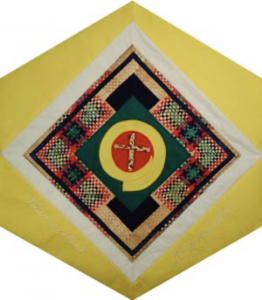Vanuatu

The Block
Within Vanuatu’s largely Christian environment, daily life is a balance between the traditional values that continue to play an important role in society, and religion. Block-designer Nikil Regenvanu chose this relationship as the theme of his block, a small cross resting on a red circular background surrounded by a yellow spiral representing a pig’s tusk. In Vanuatu’s customs, pigs are a measure of wealth and their curved tusks, which are used in celebrations and as payment from those breaking tribal practices and laws, are highly prized. An inner green frame represents the islands’ lush tropical vegetation while the colourful outer frame, woven from Pandanus leaves, exemplifies a material used in many aspects of Vanuatu daily life. From this material, women traditionally weave such items as baskets and mats for everyday use, but also create special finely woven mats for weddings and other functions. Such mats are distinctive in the Pacific because of their long, narrow shape and because of their many different colours.
Cultural Profile
Vanuatu, meaning “Land Eternal,” is an island nation in the southwestern area of the Pacific Ocean known as Melanesia. The Y-shaped archipelago, located about 5,600 km southwest of Hawaii and 2,400 km northeast of Australia, consists of four main islands and eighty smaller islands. Most of the islands––about 70 of which are inhabited––are mountainous and of volcanic origin and have tropical or sub-tropical climates. From the late 19th century until its independence in 1980 Vanuatu was jointly governed by France and Britain. It was during this period that James Cook named the islands the New Hebrides after a similarly rugged group of islands off the west coast of Scotland. More than 115 distinctly different cultures and languages still thrive in Vanuatu making it one of the most ethnically diverse nations in the world. Ethnic Melanesians, known as ni-Vanuatu, make up more than 90 percent of the population, while the remainder are of French, Vietnamese, Chinese, Polynesian or Micronesian descent. The official languages are English, French and Bislama, a form of Pidgin English that is the tongue most commonly used.
Vanuatu has strong cultural and economic ties to both Australia and New Zealand, as well as to France and Britain, and even though the ni-Vanuatu way of life varies throughout the islands, there are significant similarities. Most of the nation’s inhabitants live in rural areas where they are generally involved in subsistence agriculture or smallholder farming. Ni-Vanuatu have also developed an informal economy where items such as woven mats, pig tusks or produce are used to acquire goods or pay for school fees. It is said that no one goes hungry in Vanuatu since, when a family needs something, its members will make wealth using their skills as farmers or mat weavers.
Tourism has become one of the country’s fastest growing sectors, particularly with its exposure to viewers of the 2004 season of Survivor (the popular reality television program). Long before that, the developing island nation was the setting for author James Michener’s Tales of the South Pacific, which earned him the 1947 Pulitzer Prize and became the inspiration behind Rodger’s and Hammerstein’s musical, South Pacific.
Traditional life in Vanuatu is an ongoing cycle of ritual in which every stage of a person’s existence––birth, initiation, marriage, and death––is celebrated. Songs and dances are performed according to ancestral rules and customs and are an integral part of the celebrations. These celebrations often feature elaborate costumes, large masks, and tree-fern, wood and stone carvings created by the village men. They also feature musical instruments––on which the ni-Vanuatu pride themselves––such as the atingting kon (an intricately carved log, also called the slit-drum or slit-gong), panpipes, and conch shells that also serve as bush telephones. Gatherings are usual held at a village’s nakamal, the communal hall. Women’s usually wear the island dress. This is a long, colourful cotton dress that became popular after the arrival of Christian missionaries because it was modest and a sharp contrast to the indigenous costumes. Today, the island dress even has its own folk song.
One of Vanuatu’s most remarkable rituals, Nangol comes from the island of Pentecost. Nangol, or land diving, is a practice similar to bungee-jumping that is performed annually to ensure a bountiful yam harvest. Men, with two long vines attached to their ankles, plunge from 30-metre high, man-made platforms as villagers, dressed in traditional costumes, feverishly dance at the foot of the tower. To this day, there have only been two casualties recorded during this practice. It is said that dare-devil tourists often try to persuade the islanders to allow them to jump, but locals will not allow it for fear of injury.
Artwork serves both practical and traditional purposes in Vanuatu, as evidenced in Ambrym, home of the country’s most elaborate sand drawings. The drawings are used by villagers to illustrate legends, songs, and ceremonies, and also to leave messages. Other arts and crafts include wood carvings
Vanuatu emigration to Canada has been very minimal and since 1974, only a handful of people have made Canada their home.
Sponsor: Barkway family
